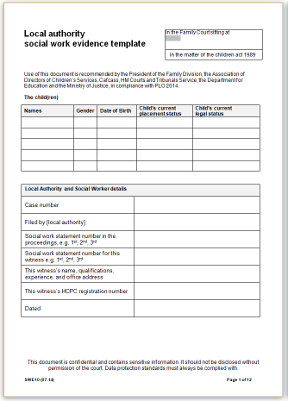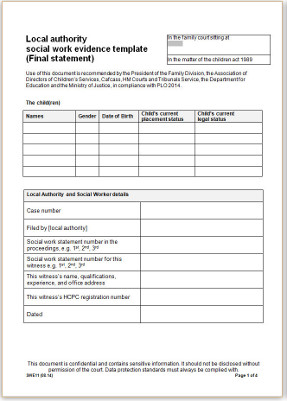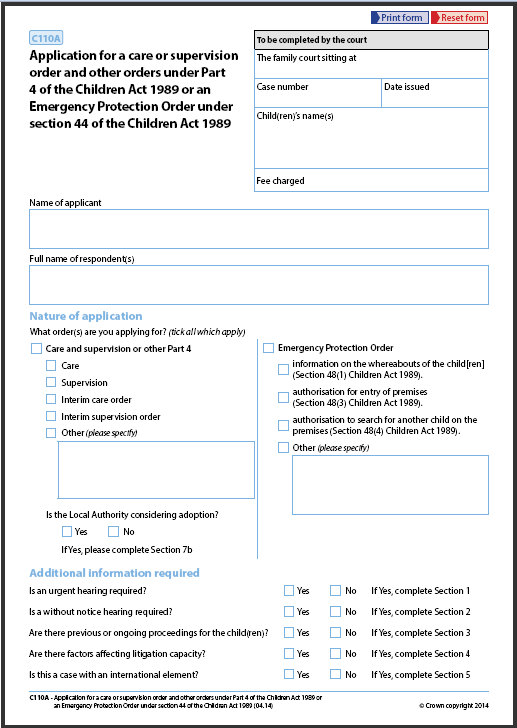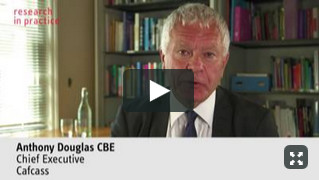Contents
Social Work Evidence template and C110a Application form
- templates and guidance:
- blank document templates for your use
- videos: the evidence template in supporting practice
- videos: practical tips in using the template
What you need to know
 The evidence template: what it does, why and how it was developed – Andrew Webb, Stockport.
The evidence template: what it does, why and how it was developed – Andrew Webb, Stockport.
Running time: 03:17
Download video direct from Vimeo
Also viewable online via Adobe Connect
(having trouble playing our videos?)
The social work evidence template has been produced by ADCS and Cafcass. It can be used by local authorities to submit an application for a care or supervision order.
The template supports professionals in submitting summarised, clear and analytical material to the court, setting out the reasons why the local authority is making an application for a specific order in relation to a child. A balanced, analytical and evidence based application will avoid unnecessary delay for the child and enable the court to quickly identify the issues in dispute, and potentially limit the cross examination of evidence.
 Collaborative working in developing and using the template – Anthony Douglas, CBE, Cafcass.
Collaborative working in developing and using the template – Anthony Douglas, CBE, Cafcass.
Running time: 02:25
Download video direct from Vimeo
Also viewable online via Adobe Connect
(having trouble playing our videos?)
This template is not mandatory but is endorsed by:
- the President of the Family Division
- the Association of Directors of Children’s Services
- Cafcass
- Her Majesty’s Courts and Tribunal Service
- Department for Education
- Ministry of Justice.
This template is compliant with the PLO 2014 and also accommodates the guidance in Re B-S (Children 2013] EWCA Civ 1146.
The social work evidence template has been designed to be used as a national template.
As a matter of good practice social work evidence statements should be proof read and checked by a manager and the legal department, before it is submitted to court. It is an important piece of evidence. Any errors or omissions within the statement could cause unnecessary delay for the child.
Templates
This section includes the Social Work Evidence Templates and the C110A Application template.
Social Work Evidence Template (SWET)
Documents in this area for your use include:
 SWE11 Local authority Social Work Evidence Template – blank for use
SWE11 Local authority Social Work Evidence Template – blank for use
SWE11 Local authority social work evidence blank template final (16/02/16)
Word 97-2003 .DOC file
You can add rows to the chronology and section 3.2 by simply using ‘tab’ at the end of the final row to create further rows, as in any normal MS-Word table.
 SWE11 Local authority social work final analysis – blank for use
SWE11 Local authority social work final analysis – blank for use
SWE11 Local authority social work final analysis blank template revised version (09/02/16)
Word 97-2003 .DOC file
 C110A Application template – blank for use
C110A Application template – blank for use
Download: C110A Application blank template final (13/08/14)A .PDF file
Documents for court
Once the statement is approved by your manager and the legal department, it will be sent to the Court by your legal department with the following documentation:
- Assessments. Any available assessments should be filed as separate documents. This could include parenting assessments, kinship care assessments, child development or adult mental health assessments etc. Reference to the outcomes of these assessments these can be made within the social work evidence statement. For more information on completing succinct and evidence based assessments see the section on Assessements and the section on Family and Friends Placements for assessment of family and friends
- Threshold Criteria document. This document is likely to be drafted by the legal department and contained within the application form C110A
- Care Plan. This is a separate document and must be drafted in accordance with the Care Planning, Placement and Case Review (England) Regulations 2010 (as amended)
- Index of checklist documents, including:
(a) evidential documents and
(b) decision making records
This document is likely to be drafted by the legal department with assistance from practitioners - Application form C110A. This is likely to be drafted by the legal department with assistance from practitioners.
The evidence statement already includes a chronology so the filing of a separate chronology may not be necessary. For more information on completing chronologies see the section ‘Chronologies’.
Further guidance on the C110A application can be found in the section Court Orders – Section 31 Application.
Training
 Why a national social work template is needed – Anthony Douglas, CBE, Cafcass.
Why a national social work template is needed – Anthony Douglas, CBE, Cafcass.
Running time: 01:49
Download video direct from Vimeo
Also viewable online via Adobe Connect
(having trouble playing our videos?)
If you require assistance in completing the social work evidence template either because you are newly qualified social worker or if your local authority has only recently decided to implement the template, do discuss this with your manager. It is recognised that social workers will require support and training to make the template fulfill its purpose.
Learning resources
 The evidence template in supporting practice – Andrew Webb, Stockport.
The evidence template in supporting practice – Andrew Webb, Stockport.
Running time: 02:08
Download video direct from Vimeo
Also viewable online via Adobe Connect
(having trouble playing our videos?)
The social work evidence statement must contain analysis of the potential risks and benefits of all the realistic placement options for each child. This might include a return to parents, placement with extended family or friends, long term foster care or adoption. This is essential and in accordance with prominent case law – Re B (A Child) [2013] 33 and Re B-S (Children 2013] EWCA Civ 1146.
 Practical tips on filling in the evidence template – Anthony Douglas, CBE, Cafcass.
Practical tips on filling in the evidence template – Anthony Douglas, CBE, Cafcass.
Running time: 03:06
Download video direct from Vimeo
Also viewable online via Adobe Connect
(having trouble playing our videos?)
BAAF produced a Briefing Note on ‘Evaluation of Permanence Options for a child in Care Proceedings’. This BAAF Note in intended to assist social workers and others in preparing a statement for court which sets out the ‘balancing exercise’ referred to within Re B and Re B-S.
A useful tool for evaluating the placement options for a child can be found in Munro’s decision tree in Munro E (2002) Effective Child Protection. Los Angeles: Sage Publications.
A research based tool for assessing the risk of further child maltreatment when reunification is being considered. This is based on the work of Jones D, Hindley N and Ramchandani P (2006). Examples of how to complete the tool and how it can be used can be found in the risk assessment tools Case study (PDF) and Worked risk assessment tool (PDF) as well as a blank form for professionals to use: blank risk assessment tool (PDF).






